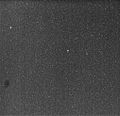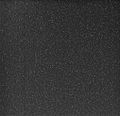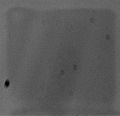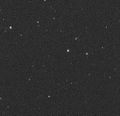Image sensor calibration
Image sensor calibration is often a two-stage process of correcting the raw image from an image sensor with the help of a white image and a dark image .
Dark image
A dark image (engl. Dark Frame ) is a photograph with a covered CCD - or CMOS camera with the same exposure time and operating temperature as the raw image. It is particularly useful for long-term recordings (e.g. in astrophotography ) to first remove the image noise that has arisen from the dark current. For this purpose, the dark image is subtracted from the raw image (dark image or dark frame correction). The individual pixels react differently to temperature influences, which means that for a certain CCD temperature each pixel generates a different current for black. For a specific pixel, the dark current fluctuates around a constant value so that a correction is possible. Pixels with a particularly high dark current, which therefore appear bright on the image, are called hot pixels . In scientific applications such as spectroscopy, dark current correction is often necessary in order to minimize the detection limits for substances. Dark current correction is often absolutely necessary, especially for methods such as DOAS , since the 'dark current spectra' often have strong differential structures that can noticeably falsify the measurement results. This procedure is also common in astronomy.
White screen
In order to be able to compensate for differences in brightness in the image, which are due to impurities on the sensor ( dust ), uneven sensitivity of the pixels, or the optics used ( vignetting , reflections ), the white image is recorded by aligning the instrument on an evenly illuminated surface . The raw image (from which the dark image has already been subtracted) is divided by the white image (white image or flat field correction) and multiplied by the mean value of the white image. If, for example, a pixel of the chip is 50% covered by dust, the intensity measured there is reduced both in the image of the recorded object and in the white image. By dividing by the small brightness value in the white image, the brightness value in the image of the object is raised to the value it would have without dust.
example
The pictures show the calibration using the example of an astronomical recording:
- The raw image shows numerous “ hot pixels ”, which lead to a very noisy image. Faint stars are lost in this noise. Dark spots in the raw image are caused by dust in the CCD camera.
- The dark image was taken with the same exposure time and operating temperature as the raw image, but with the camera shutter closed . It thus records the dark current that has accumulated during the corresponding exposure time .
- The white image was taken with the instrument aimed at a uniformly lit area. It detects irregularities in the illumination of the image (e.g. due to dust) and in the sensitivity of the individual pixels.
- These defects have been corrected in the calibrated image. Faint stars can also be seen here. The calibrated image can be used for quantitative analysis, for example for measuring the apparent brightness of the stars. Without calibration, such a measurement would lead to incorrect measured values.



